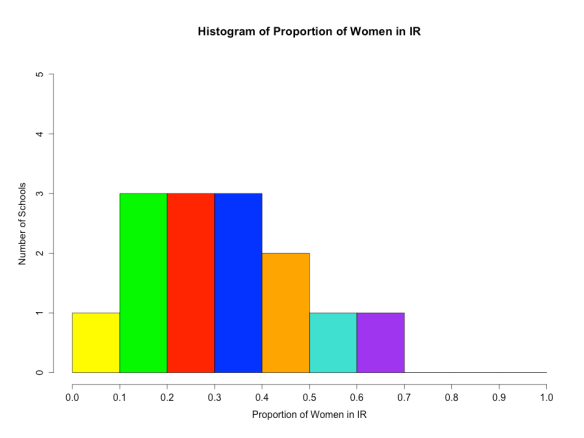By Suparna Chaudhry and William Nomikos
A couple of weeks ago, Barbara Walter and Taylor Marvin over at Political Violence @ a Glance asked why so few women in IR blog. They offered four potential explanations for the dearth of women in this part of the blogosphere: a lack of tenured women employed by elite research universities, imbalances in invitations to participate in blogs, outright sexism as a deterrent to blogging, and, finally, a low willingness of women to participate in blogs. At the Smoke-Filled Room, 3 out of our 12 bloggers are women or, looking solely at those who have IR as a concentration, 2 out of 9. Neither figure reflects equality in any real sense and so, given our existence as an exclusively graduate student blog, we wanted to dig a bit deeper into the mechanisms Walter and Marvin offer. Ultimately, we suggest that the lack of female bloggers in IR and, in particular, female graduate student bloggers, is a direct result of extreme gender imbalances that exist within graduate political science departments where two-thirds of students studying International Relations are male and only one-third is female.
In a related post, Jeremy Pressman asks whether the high percentage of tenured, male faculty in IR programs might just be a reflection of students in top PhD programs. To see if the paucity of female bloggers in international politics is just a reflection of the low number of women studying these topics in the top PhD programs, we looked at the distribution of women studying international relations and comparative politics across 17 schools (Top 20 schools selected non-randomly). Though the initial post did raise a question about the paucity of women specifically in IR, a look at some of the prominent blogs in the field such as The Monkey Cage, Duck of Minerva & Political Violence @ a Glance shows that posts are often made by comparativists as well.

Figure 1: Proportion of men and women studying International Relations, Comparative Politics, and Political Science in Top 20 Political Science Departments.
As Figure 1 shows, there is no paucity of women studying comparative politics. In fact, across the 14 schools that listed subfield interests for their doctoral students women have virtually equal representation (about 47%). Data from International Relations paint an entirely different picture. Only 33% of IR graduate students at these 14 schools are women. These numbers are especially stark compared to the gender balance across subfields. As we can see, women remain underrepresented in graduate programs in political science (39%) but much of this is due to one subfield—International Relations (American Politics is about equal; Political Economy, Methodology, and Political Theory are all skewed somewhat toward men).

Figure 2: A histogram of the distribution of the proportion of women studying International Relations at Top 20 Political Science departments.
Digging deeper, we can see from Figure 2 that only 2 schools have more women than men studying IR. And only 4 out of the 14 have at least 40% women. By contrast, 13 out of the 14 have at least 40% men studying IR. Clearly, a serious imbalance exists, which, in turn might lead to fewer women—in graduate school and in academia more broadly—blogging.
But, might it be the case instead that women are simply more reticent to post on and join blogs? This could be due to various potential causal mechanisms. First, foreign female students may not feel as comfortable voicing their opinions, especially if English is not their first language. However, since foreign male students are likely to face a similar language barrier, it may be the case that different cultures prescribe different norms of behavior, in particular with regard to the role of women in public and political life. It is perhaps the interaction between cultural differences and gender differences that makes international women more hesitant to blog. Second, looking beyond foreign students, it is also possible that women’s reticence to post, regardless of the geographical location of their prior education, could also have something to do with their classroom experiences, something that we are unable to capture just by looking at the distribution of women in PhD programs.
Relatedly, might IR blogs simply post about topics that women do not study? A 2006 TRIP survey of 1,112 IR faculty throughout the United States revealed certain dissimilarities between men and women in their status in the profession, approaches to teaching and scholarship, “Women study substantively different issue areas. Higher percentages of female than male faculty study international organization (+6%), international political economy (+3%), international law (+2%), the environment (+2%) and human rights (+1%). Higher percentages of men, in contrast, study U.S. foreign policy (+13%), international security (+6%), IR theory (+2%), and comparative foreign policy (+1%). These findings are consistent with evidence from the broader field of political science. The APSA divisions with the lowest female representation include international security and arms control, international collaboration, foreign policy, conflict processes, and international history and politics (Gruberg 2007). Indeed, fewer women are found in the field of IR than in American and comparative politics (Sedowski and Brintall 2007).” If our blogs are actually focusing more on such topics, then it is possible that some women may feel deterred to post about topics such as international organizations, law and so on, for fear that it may not generate enough interest. This perception could also be related to what is considered as “popular” or prominent in mainstream media, which tends to focus more on security and conflict-related topics, rather than topics related to international and non-governmental organizations and political economy.
Furthermore, Walter and Marvin, using the experience of Political Violence @ a Glance, suggest that it might be the case that fewer women are asked to join blogs. While this might be the case (the invitation process at the Smoke-Filled Room was similarly uneven), it seems more likely that this might also simply be a product of the imbalance that already exists. Additionally, as a blog, the Smoke-Filled Room has not faced any sexist attacks. Nonetheless, we acknowledge that these attacks occur and may serve as a deterrent for women. At this time, however, we are hesitant to draw any conclusions about how this could affect membership of our blog specifically and IR blogs more generally.
Nonetheless, we find little evidence that women are less likely than men to blog. Admittedly, the aforementioned factors, which might deter women from blogging, might reinforce the difficulties caused by the paucity of women in graduate programs but we doubt that these factors alone have pushed women out of the blogosphere. Let’s hypothesize that women and men are equally likely to blog. Let’s also posit an alternative hypothesis that men are more likely than women to blog. Given the structure of graduate departments, what is the probability that the Smoke-Filled Room would select 3 or fewer women out of 12 bloggers (or 2 out of 9 IR bloggers)? Given this probability, how confident do we feel in rejecting the null hypothesis that women and men are equally likely to blog? A very low probability (p<0.05, by convention) would suggest that it is unlikely that women joined the Smoke-Filled Room at such a low rate by chance.
To calculate this, we ran 10,000 simulated draws of bloggers from a pool of the 17 graduate schools for which we collected data. In 24% of these draws did the Smoke-Filled Room select 3 or fewer female bloggers (see Figure 3). When we restricted the sample to simply IR students (data from 14 schools), we found that in 40% of the draws, the Smoke-Filled Room selected 2 or fewer female IR bloggers (see Figure 4). We would not reject the null in either case at traditional levels. Therefore, we cannot conclude from the small number of female bloggers at the Smoke-Filled Room that women are less likely than men to blog. The reason is, quite simply, that the distribution of women in graduate programs and, in particular in IR, is so skewed toward men that it is difficult to find enough women to join blogs. The simulations reflect this fact as well. In fact, in a staggering 87% of the simulations, the Smoke-Filled Room selected more male than female IR bloggers.

Figure 3: Histogram of simulations of draws from all Political Science students for bloggers for the Smoke-Filled Room. X-axis indicates number of women selected to join blog.

Figure 4: Histogram of simulations of draws from only International Relations students for bloggers for the Smoke-Filled Room. X-axis indicates number of women selected to join blog.
Thus, the evidence suggests that women are not less likely to blog than men are. These findings align with our own experiences at the Smoke-Filled Room where our female bloggers, though fewer in number, have been just as active as our male bloggers. Indeed, the blogging process, even within International Relations, does not seem to be inherently flawed and sexist. Yet, as Walter and Marvin correctly point out, women do blog in smaller numbers than men do. Why? Our data gathered from Top 20 Political Science departments revealed a tremendous gender imbalance among PhD students of International Relations–33% are women, 67% are men. As our statistical analyses imply, the biggest problem appears to be structural gender imbalances within PhD programs. As we write, it is possible that issues such as women’s reticence to post, sexism on the Internet, the nature of topics discussed on IR blogs, and a smaller proportion of invitations going out to women could potentially reinforce the effect of structural imbalances, resulting in so few female bloggers. Nonetheless, the heart of the issue is analytical prior to the blogosphere and lies with the existing structures of graduate departments around the country. If we wish to foster a more equal blogging community in International Relations, it is there we should begin.
The authors would like to thank Guadalupe Tunon and Niloufer Siddiqui for their help with this post. You can follow Suparna on Twitter here and William here.






